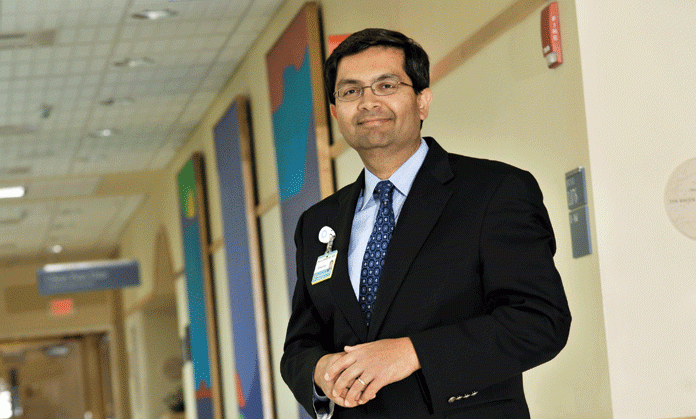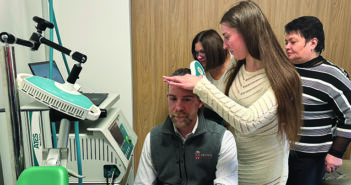When Qureshi joined the lab in 1993, Lerner was studying parasitic diseases in biting arthropods, like flies and ticks. One project required going into the swamps of Massachusetts to collect greenhead flies. Qureshi volunteered for these expeditions even though it wasn’t required for his research project. He remembers this fieldwork experience fondly. Back at the lab, Qureshi would painstakingly dissect out the fly salivary glands. “He has tremendous patience despite the world swirling around him,” Lerner says. “He’s always a sea of calm.”
For his own project, Qureshi studied the possible role of nitric oxide in toxic epidermal necrolysis—a terrible and often fatal condition that causes a person’s skin to fall off. “He wondered: what if nitric oxide is what kills off the epidermis? Maybe it’s a gas attack,” Lerner says. Qureshi was able to show that nitric oxide can indeed kill off the top layer of skin—the epidermis. But he found that the next layer down, the dermis, was protected. This is because hemoglobin, present in blood vessels in the dermis but absent in the epidermis, is a nitric oxide scavenger.
In a related project, Qureshi found evidence that nitric oxide is likely involved in conditions where people lose skin pigmentation, including vitiligo and age spots. This finding may someday lead to a treatment for these conditions. “Is it the case that if you block nitrous oxide you might be able to block this loss of pigmentation in these nasty skin conditions?” Lerner says. “I think the answer to that question is a qualified yes.”
Population patterns
When Qureshi returned to his clinical training, he knew he wanted to continue to do research—but this time in humans. In order to gather the tools he needed to study people, he completed a Master of Public Health at the Harvard School of Public Health. There he developed an interest in population science.
Population science involves gathering data by observing the health outcomes of large numbers of people. At Brown, Qureshi’s goal is to develop ongoing observational studies of various skin diseases and to share data with researchers doing population science studies in other fields. He hopes that these studies will lead to improvements in health care.
Rhode Island is an ideal place to do these kinds of studies because people are relatively easy to track. They rarely move out of state (hence all the “I never leave Rhode Island” bumper stickers) and often go to the same clinics and pharmacies for many years. “It’s a naturally closed cohort,” Qureshi says. Furthermore, about one-fifth of Rhode Islanders are not Caucasian, and skin problems vary across races. “Rhode Island happens to be a state with a diverse population, so it’s the perfect setup,” he says. “You couldn’t do that in New Hampshire.”
Qureshi directs one population study that could have national significance. He wants to use data from Rhode Islanders
to develop a screening protocol for skin cancer. Such protocols exist for other cancers: they are why doctors recommend colonoscopies for people over 50 and mammograms for women over 40, for example. “Currently there are no national guidelines for skin cancer screening; they don’t exist,” Qureshi says. “We need to determine what age we should start screening and how often.”
Right now he is analyzing existing information to see what patterns of care have been the most successful (and cost effective) for identifying skin cancers. He will continue to track patient outcomes and wants to eventually develop a screening regimen that could be tested in real time.
It turns out that the Affordable Care Act may be increasing the data available for this study. As more people become insured, there has been an increased demand for dermatologists. When people have health insurance, they are more likely to visit a primary care physician, who may express concern over an oddlooking mole or other potential skin problem. While this is good for patients and good for Qureshi’s population studies, he is concerned that increased demand might strain the system.
Qureshi is trying to meet this need by hiring 10 new faculty since arriving at Brown. But he says he is committed to making smart hiring decisions. “We have a great group of people here and they work very well together,” he says. “Good people are a good investment long term.”




